stop start JEEP CHEROKEE 2020 Owner handbook (in English)
[x] Cancel search | Manufacturer: JEEP, Model Year: 2020, Model line: CHEROKEE, Model: JEEP CHEROKEE 2020Pages: 332, PDF Size: 8.87 MB
Page 79 of 332
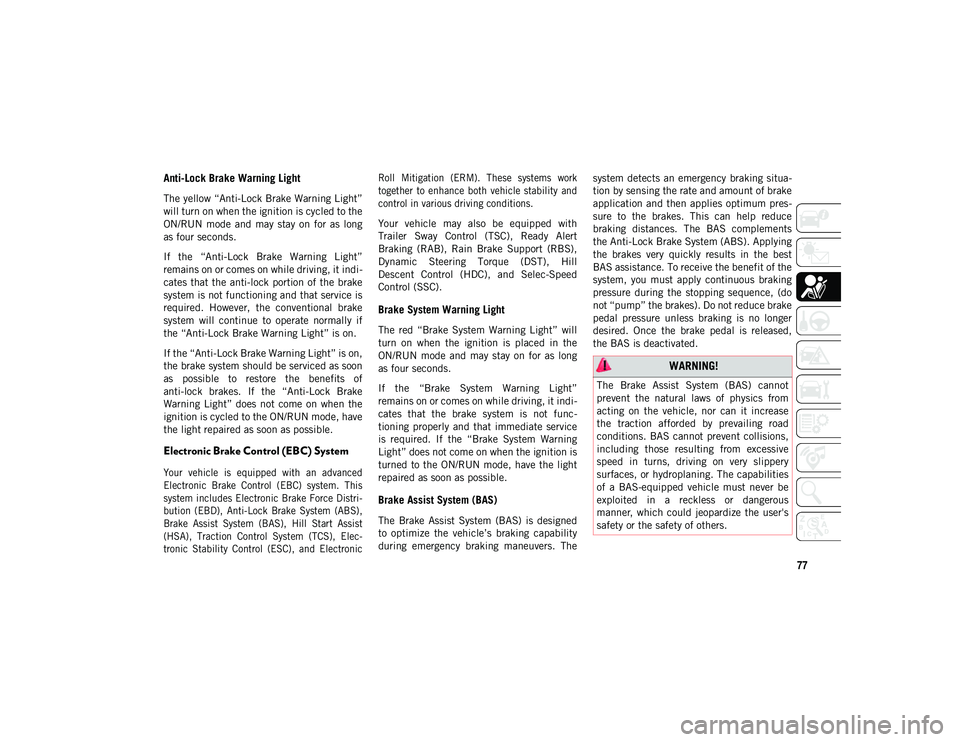
77
Anti-Lock Brake Warning Light
The yellow “Anti-Lock Brake Warning Light”
will turn on when the ignition is cycled to the
ON/RUN mode and may stay on for as long
as four seconds.
If the “Anti-Lock Brake Warning Light”
remains on or comes on while driving, it indi-
cates that the anti-lock portion of the brake
system is not functioning and that service is
required. However, the conventional brake
system will continue to operate normally if
the “Anti-Lock Brake Warning Light” is on.
If the “Anti-Lock Brake Warning Light” is on,
the brake system should be serviced as soon
as possible to restore the benefits of
anti-lock brakes. If the “Anti-Lock Brake
Warning Light” does not come on when the
ignition is cycled to the ON/RUN mode, have
the light repaired as soon as possible.
Electronic Brake Control (EBC) System
Your vehicle is equipped with an advanced
Electronic Brake Control (EBC) system. This
system includes Electronic Brake Force Distri -
bution (EBD), Anti-Lock Brake System (ABS),
Brake Assist System (BAS), Hill Start Assist
(HSA), Traction Control System (TCS), Elec-
tronic Stability Control (ESC), and Electronic Roll Mitigation (ERM). These systems work
together to enhance both vehicle stability and
control in various driving conditions.
Your vehicle may also be equipped with
Trailer Sway Control (TSC), Ready Alert
Braking (RAB), Rain Brake Support (RBS),
Dynamic Steering Torque (DST), Hill
Descent Control (HDC), and Selec-Speed
Control (SSC).
Brake System Warning Light
The red “Brake System Warning Light” will
turn on when the ignition is placed in the
ON/RUN mode and may stay on for as long
as four seconds.
If the “Brake System Warning Light”
remains on or comes on while driving, it indi
-
cates that the brake system is not func -
tioning properly and that immediate service
is required. If the “Brake System Warning
Light” does not come on when the ignition is
turned to the ON/RUN mode, have the light
repaired as soon as possible.
Brake Assist System (BAS)
The Brake Assist System (BAS) is designed
to optimize the vehicle’s braking capability
during emergency braking maneuvers. The system detects an emergency braking situa
-
tion by sensing the rate and amount of brake
application and then applies optimum pres -
sure to the brakes. This can help reduce
braking distances. The BAS complements
the Anti-Lock Brake System (ABS). Applying
the brakes very quickly results in the best
BAS assistance. To receive the benefit of the
system, you must apply continuous braking
pressure during the stopping sequence, (do
not “pump” the brakes). Do not reduce brake
pedal pressure unless braking is no longer
desired. Once the brake pedal is released,
the BAS is deactivated.
WARNING!
The Brake Assist System (BAS) cannot
prevent the natural laws of physics from
acting on the vehicle, nor can it increase
the traction afforded by prevailing road
conditions. BAS cannot prevent collisions,
including those resulting from excessive
speed in turns, driving on very slippery
surfaces, or hydroplaning. The capabilities
of a BAS-equipped vehicle must never be
exploited in a reckless or dangerous
manner, which could jeopardize the user's
safety or the safety of others.
2020_JEEP_CHEROKEE_UG_RHD_UK.book Page 77
Page 82 of 332
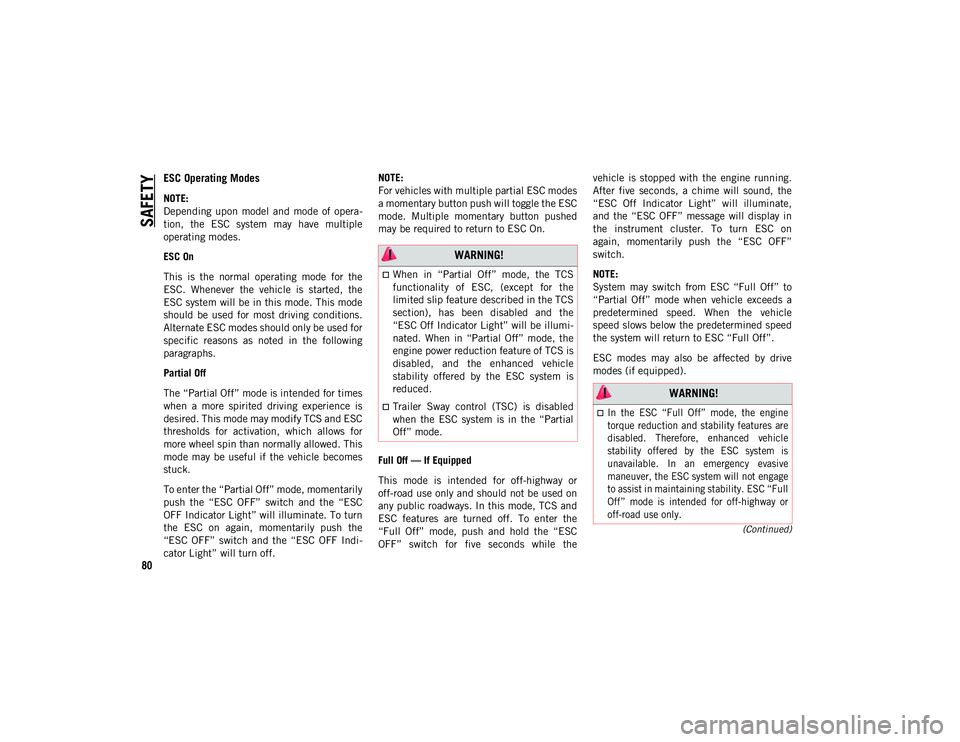
SAFETY
80
(Continued)
ESC Operating Modes
NOTE:
Depending upon model and mode of opera-
tion, the ESC system may have multiple
operating modes.
ESC On
This is the normal operating mode for the
ESC. Whenever the vehicle is started, the
ESC system will be in this mode. This mode
should be used for most driving conditions.
Alternate ESC modes should only be used for
specific reasons as noted in the following
paragraphs.
Partial Off
The “Partial Off” mode is intended for times
when a more spirited driving experience is
desired. This mode may modify TCS and ESC
thresholds for activation, which allows for
more wheel spin than normally allowed. This
mode may be useful if the vehicle becomes
stuck.
To enter the “Partial Off” mode, momentarily
push the “ESC OFF” switch and the “ESC
OFF Indicator Light” will illuminate. To turn
the ESC on again, momentarily push the
“ESC OFF” switch and the “ESC OFF Indi -
cator Light” will turn off. NOTE:
For vehicles with multiple partial ESC modes
a momentary button push will toggle the ESC
mode. Multiple momentary button pushed
may be required to return to ESC On.
Full Off — If Equipped
This mode is intended for off-highway or
off-road use only and should not be used on
any public roadways. In this mode, TCS and
ESC features are turned off. To enter the
“Full Off” mode, push and hold the “ESC
OFF” switch for five seconds while the
vehicle is stopped with the engine running.
After five seconds, a chime will sound, the
“ESC Off Indicator Light” will illuminate,
and the “ESC OFF” message will display in
the instrument cluster. To turn ESC on
again, momentarily push the “ESC OFF”
switch.
NOTE:
System may switch from ESC “Full Off” to
“Partial Off” mode when vehicle exceeds a
predetermined speed. When the vehicle
speed slows below the predetermined speed
the system will return to ESC “Full Off”.
ESC modes may also be affected by drive
modes (if equipped).
WARNING!
When in “Partial Off” mode, the TCS
functionality of ESC, (except for the
limited slip feature described in the TCS
section), has been disabled and the
“ESC Off Indicator Light” will be illumi
-
nated. When in “Partial Off” mode, the
engine power reduction feature of TCS is
disabled, and the enhanced vehicle
stability offered by the ESC system is
reduced.
Trailer Sway control (TSC) is disabled
when the ESC system is in the “Partial
Off” mode.
WARNING!
In the ESC “Full Off” mode, the engine
torque reduction and stability features are
disabled. Therefore, enhanced vehicle
stability offered by the ESC system is
unavailable. In an emergency evasive
maneuver, the ESC system will not engage
to assist in maintaining stability. ESC “Full
Off” mode is intended for off-highway or
off-road use only.
2020_JEEP_CHEROKEE_UG_RHD_UK.book Page 80
Page 83 of 332
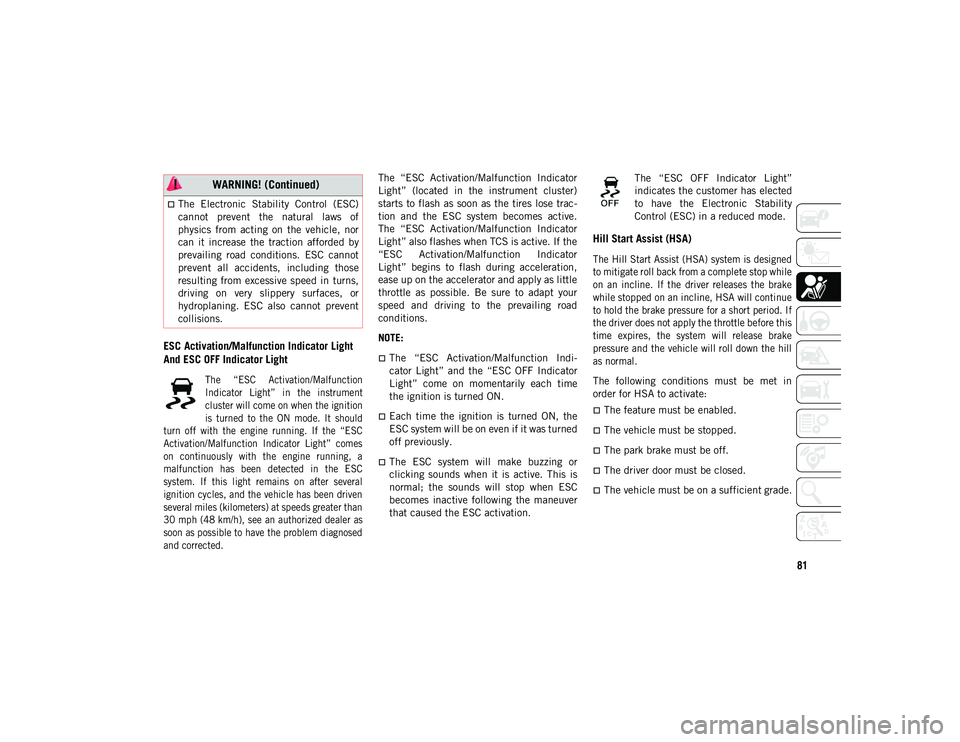
81
ESC Activation/Malfunction Indicator Light
And ESC OFF Indicator Light
The “ESC Activation/Malfunction
Indicator Light” in the instrument
cluster will come on when the ignition
is turned to the ON mode. It should
turn off with the engine running. If the “ESC
Activation/Malfunction Indicator Light” comes
on continuously with the engine running, a
malfunction has been detected in the ESC
system. If this light remains on after several
ignition cycles, and the vehicle has been driven
several miles (kilometers) at speeds greater than
30 mph (48 km/h), see an authorized dealer as
soon as possible to have the problem diagnosed
and corrected.
The “ESC Activation/Malfunction Indicator
Light” (located in the instrument cluster)
starts to flash as soon as the tires lose trac
-
tion and the ESC system becomes active.
The “ESC Activation/Malfunction Indicator
Light” also flashes when TCS is active. If the
“ESC Activation/Malfunction Indicator
Light” begins to flash during acceleration,
ease up on the accelerator and apply as little
throttle as possible. Be sure to adapt your
speed and driving to the prevailing road
conditions.
NOTE:
The “ESC Activation/Malfunction Indi -
cator Light” and the “ESC OFF Indicator
Light” come on momentarily each time
the ignition is turned ON.
Each time the ignition is turned ON, the
ESC system will be on even if it was turned
off previously.
The ESC system will make buzzing or
clicking sounds when it is active. This is
normal; the sounds will stop when ESC
becomes inactive following the maneuver
that caused the ESC activation. The “ESC OFF Indicator Light”
indicates the customer has elected
to have the Electronic Stability
Control (ESC) in a reduced mode.
Hill Start Assist (HSA)
The Hill Start Assist (HSA) system is designed
to mitigate roll back from a complete stop while
on an incline. If the driver releases the brake
while stopped on an incline, HSA will continue
to hold the brake pressure for a short period. If
the driver does not apply the throttle before this
time expires, the system will release brake
pressure and the vehicle will roll down the hill
as normal.
The following conditions must be met in
order for HSA to activate:
The feature must be enabled.
The vehicle must be stopped.
The park brake must be off.
The driver door must be closed.
The vehicle must be on a sufficient grade.
The Electronic Stability Control (ESC)
cannot prevent the natural laws of
physics from acting on the vehicle, nor
can it increase the traction afforded by
prevailing road conditions. ESC cannot
prevent all accidents, including those
resulting from excessive speed in turns,
driving on very slippery surfaces, or
hydroplaning. ESC also cannot prevent
collisions.
WARNING! (Continued)
2020_JEEP_CHEROKEE_UG_RHD_UK.book Page 81
Page 89 of 332

87
Traction Control System (TCS)
The Traction Control System (TCS) monitors
the amount of wheel spin of each of the
driven wheels. If wheel spin is detected, the
TCS may apply brake pressure to the spin-
ning wheel(s) and/or reduce engine power to
provide enhanced acceleration and stability.
A feature of the TCS, Brake Limited Differen -
tial (BLD), functions similar to a limited slip
differential and controls the wheel spin
across a driven axle. If one wheel on a driven
axle is spinning faster than the other, the
system will apply the brake of the spinning
wheel. This will allow more engine torque to
be applied to the wheel that is not spinning.
BLD may remain enabled even if TCS and
Electronic Stability Control (ESC) are in a
reduced mode.
Trailer Sway Control (TSC)
Trailer Sway Control (TSC) uses sensors in
the vehicle to recognize an excessively
swaying trailer and will take the appropriate
actions to attempt to stop the sway. TSC will
become active automatically once an exces -
sively swaying trailer is recognized. NOTE:
TSC cannot stop all trailers from swaying.
Always use caution when towing a trailer and
follow the trailer tongue weight recommen
-
dations. Refer to “Trailer Towing” in
“Starting And Operating” for further informa -
tion.
When TSC is functioning, the “ESC Activa -
tion/Malfunction Indicator Light” will flash,
the engine power may be reduced and you
may feel the brakes being applied to indi -
vidual wheels to attempt to stop the trailer
from swaying. TSC is disabled when the ESC
system is in the “Partial Off” or “Full Off”
modes.
AUXILIARY DRIVING
SYSTEMS
Blind Spot Monitoring (BSM) — If
Equipped
The Blind Spot Monitoring (BSM) system
uses two radar-based sensors, located inside
the rear bumper fascia, to detect highway
licensable vehicles (automobiles, trucks,
motorcycles, etc.) that enter the blind spot
zones from the rear/front/side of the vehicle.
Rear Detection Zones
When the vehicle is started, the BSM
warning light will momentarily illuminate in
both outside rear view mirrors to let the
driver know that the system is operational.
WARNING!
If TSC activates while driving, slow the
vehicle down, stop at the nearest safe
location, and adjust the trailer load to
eliminate trailer sway.
2020_JEEP_CHEROKEE_UG_RHD_UK.book Page 87
Page 95 of 332
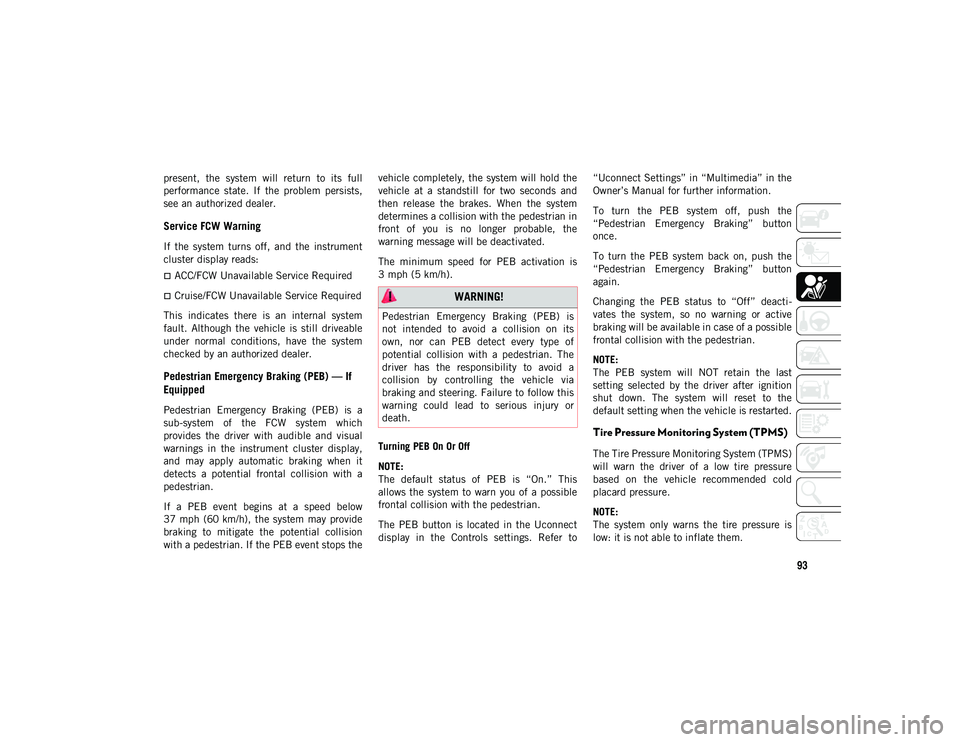
93
present, the system will return to its full
performance state. If the problem persists,
see an authorized dealer.
Service FCW Warning
If the system turns off, and the instrument
cluster display reads:
ACC/FCW Unavailable Service Required
Cruise/FCW Unavailable Service Required
This indicates there is an internal system
fault. Although the vehicle is still driveable
under normal conditions, have the system
checked by an authorized dealer.
Pedestrian Emergency Braking (PEB) — If
Equipped
Pedestrian Emergency Braking (PEB) is a
sub-system of the FCW system which
provides the driver with audible and visual
warnings in the instrument cluster display,
and may apply automatic braking when it
detects a potential frontal collision with a
pedestrian.
If a PEB event begins at a speed below
37 mph (60 km/h), the system may provide
braking to mitigate the potential collision
with a pedestrian. If the PEB event stops the vehicle completely, the system will hold the
vehicle at a standstill for two seconds and
then release the brakes. When the system
determines a collision with the pedestrian in
front of you is no longer probable, the
warning message will be deactivated.
The minimum speed for PEB activation is
3 mph (5 km/h).
Turning PEB On Or Off
NOTE:
The default status of PEB is “On.” This
allows the system to warn you of a possible
frontal collision with the pedestrian.
The PEB button is located in the Uconnect
display in the Controls settings. Refer to
“Uconnect Settings” in “Multimedia” in the
Owner’s Manual for further information.
To turn the PEB system off, push the
“Pedestrian Emergency Braking” button
once.
To turn the PEB system back on, push the
“Pedestrian Emergency Braking” button
again.
Changing the PEB status to “Off” deacti
-
vates the system, so no warning or active
braking will be available in case of a possible
frontal collision with the pedestrian.
NOTE:
The PEB system will NOT retain the last
setting selected by the driver after ignition
shut down. The system will reset to the
default setting when the vehicle is restarted.
Tire Pressure Monitoring System (TPMS)
The Tire Pressure Monitoring System (TPMS)
will warn the driver of a low tire pressure
based on the vehicle recommended cold
placard pressure.
NOTE:
The system only warns the tire pressure is
low: it is not able to inflate them.
WARNING!
Pedestrian Emergency Braking (PEB) is
not intended to avoid a collision on its
own, nor can PEB detect every type of
potential collision with a pedestrian. The
driver has the responsibility to avoid a
collision by controlling the vehicle via
braking and steering. Failure to follow this
warning could lead to serious injury or
death.
2020_JEEP_CHEROKEE_UG_RHD_UK.book Page 93
Page 102 of 332
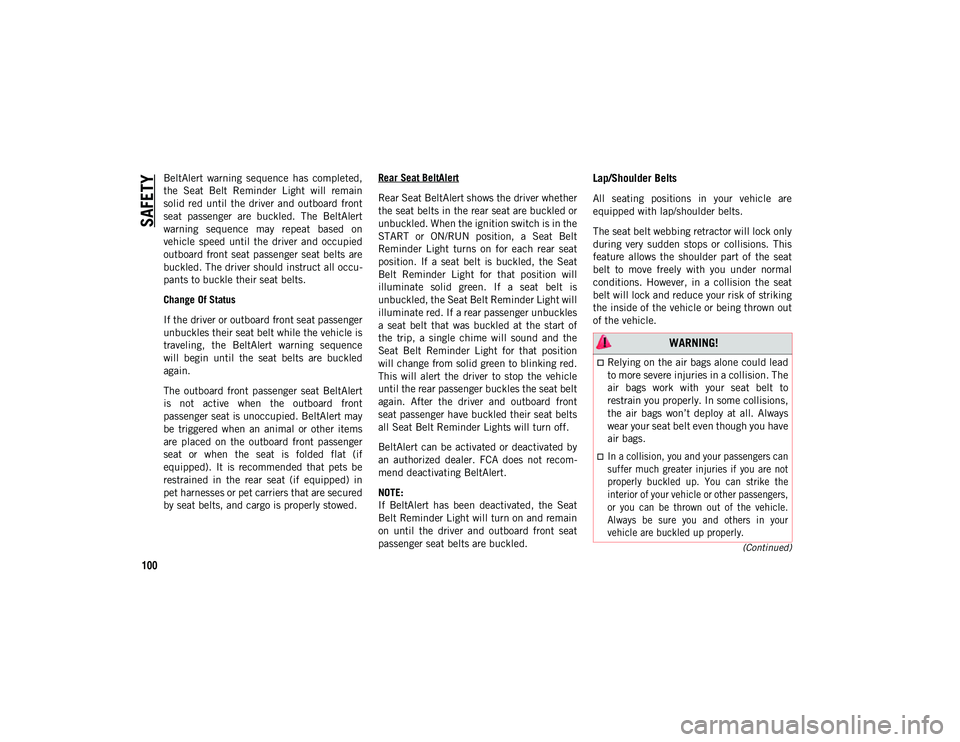
SAFETY
100
(Continued)
BeltAlert warning sequence has completed,
the Seat Belt Reminder Light will remain
solid red until the driver and outboard front
seat passenger are buckled. The BeltAlert
warning sequence may repeat based on
vehicle speed until the driver and occupied
outboard front seat passenger seat belts are
buckled. The driver should instruct all occu-
pants to buckle their seat belts.
Change Of Status
If the driver or outboard front seat passenger
unbuckles their seat belt while the vehicle is
traveling, the BeltAlert warning sequence
will begin until the seat belts are buckled
again.
The outboard front passenger seat BeltAlert
is not active when the outboard front
passenger seat is unoccupied. BeltAlert may
be triggered when an animal or other items
are placed on the outboard front passenger
seat or when the seat is folded flat (if
equipped). It is recommended that pets be
restrained in the rear seat (if equipped) in
pet harnesses or pet carriers that are secured
by seat belts, and cargo is properly stowed. Rear Seat BeltAlert
Rear Seat BeltAlert shows the driver whether
the seat belts in the rear seat are buckled or
unbuckled. When the ignition switch is in the
START or ON/RUN position, a Seat Belt
Reminder Light turns on for each rear seat
position. If a seat belt is buckled, the Seat
Belt Reminder Light for that position will
illuminate solid green. If a seat belt is
unbuckled, the Seat Belt Reminder Light will
illuminate red. If a rear passenger unbuckles
a seat belt that was buckled at the start of
the trip, a single chime will sound and the
Seat Belt Reminder Light for that position
will change from solid green to blinking red.
This will alert the driver to stop the vehicle
until the rear passenger buckles the seat belt
again. After the driver and outboard front
seat passenger have buckled their seat belts
all Seat Belt Reminder Lights will turn off.
BeltAlert can be activated or deactivated by
an authorized dealer. FCA does not recom
-
mend deactivating BeltAlert.
NOTE:
If BeltAlert has been deactivated, the Seat
Belt Reminder Light will turn on and remain
on until the driver and outboard front seat
passenger seat belts are buckled.
Lap/Shoulder Belts
All seating positions in your vehicle are
equipped with lap/shoulder belts.
The seat belt webbing retractor will lock only
during very sudden stops or collisions. This
feature allows the shoulder part of the seat
belt to move freely with you under normal
conditions. However, in a collision the seat
belt will lock and reduce your risk of striking
the inside of the vehicle or being thrown out
of the vehicle.
WARNING!
Relying on the air bags alone could lead
to more severe injuries in a collision. The
air bags work with your seat belt to
restrain you properly. In some collisions,
the air bags won’t deploy at all. Always
wear your seat belt even though you have
air bags.
In a collision, you and your passengers can
suffer much greater injuries if you are not
properly buckled up. You can strike the
interior of your vehicle or other passengers,
or you can be thrown out of the vehicle.
Always be sure you and others in your
vehicle are buckled up properly.
2020_JEEP_CHEROKEE_UG_RHD_UK.book Page 100
Page 118 of 332
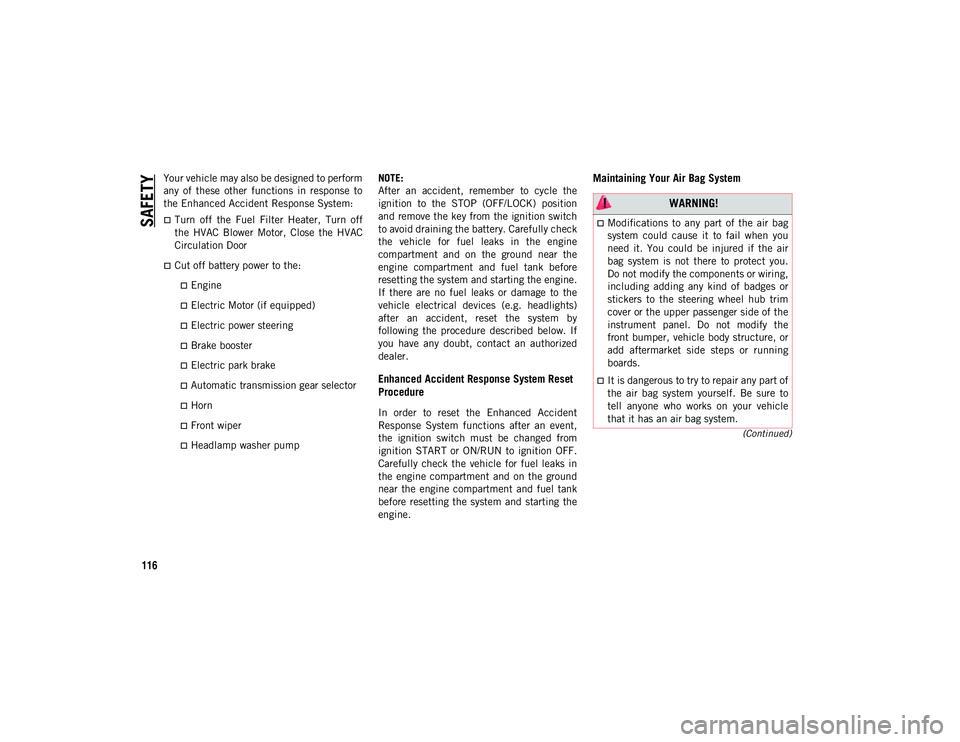
SAFETY
116
(Continued)
Your vehicle may also be designed to perform
any of these other functions in response to
the Enhanced Accident Response System:
Turn off the Fuel Filter Heater, Turn off
the HVAC Blower Motor, Close the HVAC
Circulation Door
Cut off battery power to the:
Engine
Electric Motor (if equipped)
Electric power steering
Brake booster
Electric park brake
Automatic transmission gear selector
Horn
Front wiper
Headlamp washer pumpNOTE:
After an accident, remember to cycle the
ignition to the STOP (OFF/LOCK) position
and remove the key from the ignition switch
to avoid draining the battery. Carefully check
the vehicle for fuel leaks in the engine
compartment and on the ground near the
engine compartment and fuel tank before
resetting the system and starting the engine.
If there are no fuel leaks or damage to the
vehicle electrical devices (e.g. headlights)
after an accident, reset the system by
following the procedure described below. If
you have any doubt, contact an authorized
dealer.
Enhanced Accident Response System Reset
Procedure
In order to reset the Enhanced Accident
Response System functions after an event,
the ignition switch must be changed from
ignition START or ON/RUN to ignition OFF.
Carefully check the vehicle for fuel leaks in
the engine compartment and on the ground
near the engine compartment and fuel tank
before resetting the system and starting the
engine.
Maintaining Your Air Bag System
WARNING!
Modifications to any part of the air bag
system could cause it to fail when you
need it. You could be injured if the air
bag system is not there to protect you.
Do not modify the components or wiring,
including adding any kind of badges or
stickers to the steering wheel hub trim
cover or the upper passenger side of the
instrument panel. Do not modify the
front bumper, vehicle body structure, or
add aftermarket side steps or running
boards.
It is dangerous to try to repair any part of
the air bag system yourself. Be sure to
tell anyone who works on your vehicle
that it has an air bag system.
2020_JEEP_CHEROKEE_UG_RHD_UK.book Page 116
Page 141 of 332
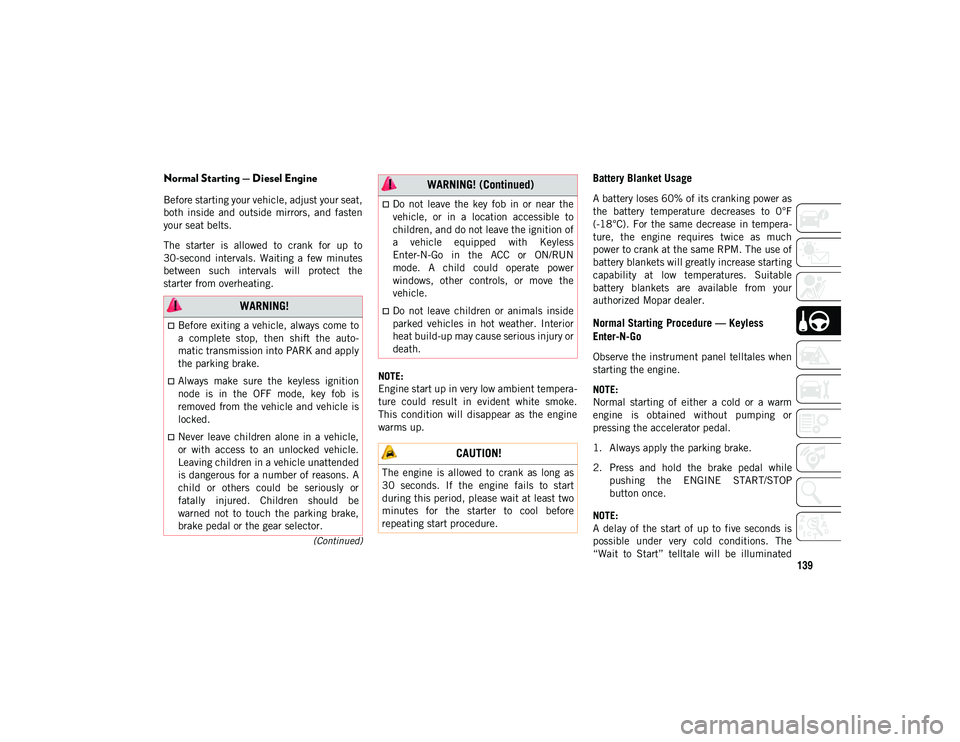
139
(Continued)
Normal Starting — Diesel Engine
Before starting your vehicle, adjust your seat,
both inside and outside mirrors, and fasten
your seat belts.
The starter is allowed to crank for up to
30-second intervals. Waiting a few minutes
between such intervals will protect the
starter from overheating.NOTE:
Engine start up in very low ambient tempera-
ture could result in evident white smoke.
This condition will disappear as the engine
warms up.
Battery Blanket Usage
A battery loses 60% of its cranking power as
the battery temperature decreases to 0°F
(-18°C). For the same decrease in tempera -
ture, the engine requires twice as much
power to crank at the same RPM. The use of
battery blankets will greatly increase starting
capability at low temperatures. Suitable
battery blankets are available from your
authorized Mopar dealer.
Normal Starting Procedure — Keyless
Enter-N-Go
Observe the instrument panel telltales when
starting the engine.
NOTE:
Normal starting of either a cold or a warm
engine is obtained without pumping or
pressing the accelerator pedal.
1. Always apply the parking brake.
2. Press and hold the brake pedal while pushing the ENGINE START/STOP
button once.
NOTE:
A delay of the start of up to five seconds is
possible under very cold conditions. The
“Wait to Start” telltale will be illuminated
WARNING!
Before exiting a vehicle, always come to
a complete stop, then shift the auto-
matic transmission into PARK and apply
the parking brake.
Always make sure the keyless ignition
node is in the OFF mode, key fob is
removed from the vehicle and vehicle is
locked.
Never leave children alone in a vehicle,
or with access to an unlocked vehicle.
Leaving children in a vehicle unattended
is dangerous for a number of reasons. A
child or others could be seriously or
fatally injured. Children should be
warned not to touch the parking brake,
brake pedal or the gear selector.
Do not leave the key fob in or near the
vehicle, or in a location accessible to
children, and do not leave the ignition of
a vehicle equipped with Keyless
Enter-N-Go in the ACC or ON/RUN
mode. A child could operate power
windows, other controls, or move the
vehicle.
Do not leave children or animals inside
parked vehicles in hot weather. Interior
heat build-up may cause serious injury or
death.
CAUTION!
The engine is allowed to crank as long as
30 seconds. If the engine fails to start
during this period, please wait at least two
minutes for the starter to cool before
repeating start procedure.
WARNING! (Continued)
2020_JEEP_CHEROKEE_UG_RHD_UK.book Page 139
Page 142 of 332
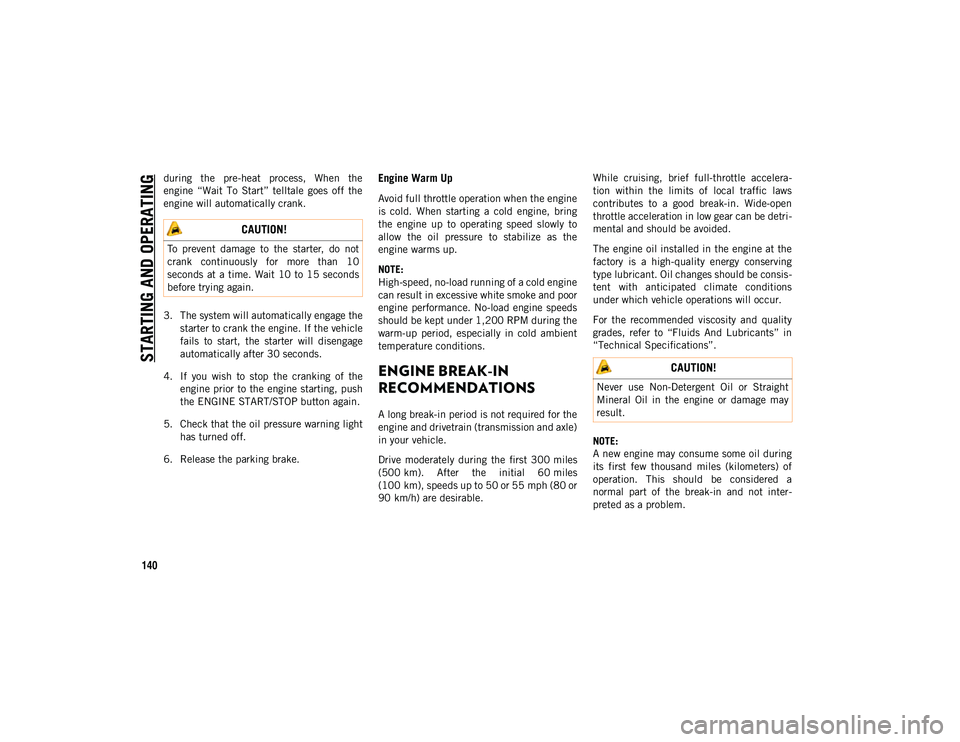
STARTING AND OPERATING
140
during the pre-heat process, When the
engine “Wait To Start” telltale goes off the
engine will automatically crank.
3. The system will automatically engage thestarter to crank the engine. If the vehicle
fails to start, the starter will disengage
automatically after 30 seconds.
4. If you wish to stop the cranking of the engine prior to the engine starting, push
the ENGINE START/STOP button again.
5. Check that the oil pressure warning light has turned off.
6. Release the parking brake.Engine Warm Up
Avoid full throttle operation when the engine
is cold. When starting a cold engine, bring
the engine up to operating speed slowly to
allow the oil pressure to stabilize as the
engine warms up.
NOTE:
High-speed, no-load running of a cold engine
can result in excessive white smoke and poor
engine performance. No-load engine speeds
should be kept under 1,200 RPM during the
warm-up period, especially in cold ambient
temperature conditions.
ENGINE BREAK-IN
RECOMMENDATIONS
A long break-in period is not required for the
engine and drivetrain (transmission and axle)
in your vehicle.
Drive moderately during the first 300 miles
(500 km). After the initial 60 miles
(100 km), speeds up to 50 or 55 mph (80 or
90 km/h) are desirable. While cruising, brief full-throttle accelera
-
tion within the limits of local traffic laws
contributes to a good break-in. Wide-open
throttle acceleration in low gear can be detri -
mental and should be avoided.
The engine oil installed in the engine at the
factory is a high-quality energy conserving
type lubricant. Oil changes should be consis -
tent with anticipated climate conditions
under which vehicle operations will occur.
For the recommended viscosity and quality
grades, refer to “Fluids And Lubricants” in
“Technical Specifications”.
NOTE:
A new engine may consume some oil during
its first few thousand miles (kilometers) of
operation. This should be considered a
normal part of the break-in and not inter -
preted as a problem.
CAUTION!
To prevent damage to the starter, do not
crank continuously for more than 10
seconds at a time. Wait 10 to 15 seconds
before trying again.
CAUTION!
Never use Non-Detergent Oil or Straight
Mineral Oil in the engine or damage may
result.
2020_JEEP_CHEROKEE_UG_RHD_UK.book Page 140
Page 148 of 332
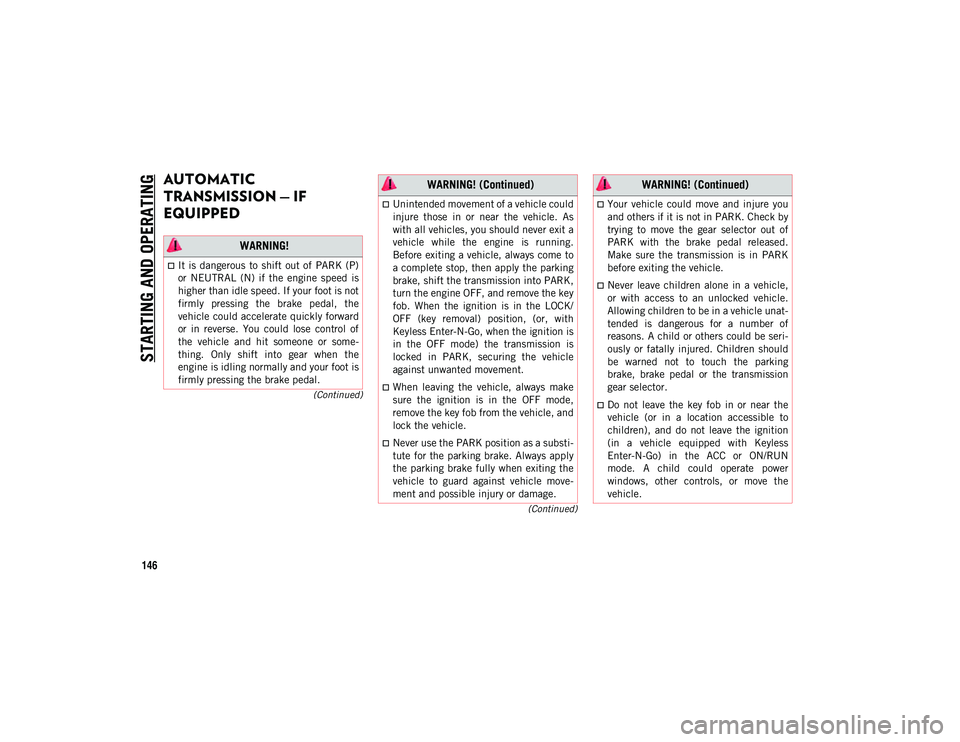
STARTING AND OPERATING
146
(Continued)
(Continued)
AUTOMATIC
TRANSMISSION — IF
EQUIPPED
WARNING!
It is dangerous to shift out of PARK (P)
or NEUTRAL (N) if the engine speed is
higher than idle speed. If your foot is not
firmly pressing the brake pedal, the
vehicle could accelerate quickly forward
or in reverse. You could lose control of
the vehicle and hit someone or some-
thing. Only shift into gear when the
engine is idling normally and your foot is
firmly pressing the brake pedal.
Unintended movement of a vehicle could
injure those in or near the vehicle. As
with all vehicles, you should never exit a
vehicle while the engine is running.
Before exiting a vehicle, always come to
a complete stop, then apply the parking
brake, shift the transmission into PARK,
turn the engine OFF, and remove the key
fob. When the ignition is in the LOCK/
OFF (key removal) position, (or, with
Keyless Enter-N-Go, when the ignition is
in the OFF mode) the transmission is
locked in PARK, securing the vehicle
against unwanted movement.
When leaving the vehicle, always make
sure the ignition is in the OFF mode,
remove the key fob from the vehicle, and
lock the vehicle.
Never use the PARK position as a substi
-
tute for the parking brake. Always apply
the parking brake fully when exiting the
vehicle to guard against vehicle move-
ment and possible injury or damage.
WARNING! (Continued)
Your vehicle could move and injure you
and others if it is not in PARK. Check by
trying to move the gear selector out of
PARK with the brake pedal released.
Make sure the transmission is in PARK
before exiting the vehicle.
Never leave children alone in a vehicle,
or with access to an unlocked vehicle.
Allowing children to be in a vehicle unat -
tended is dangerous for a number of
reasons. A child or others could be seri -
ously or fatally injured. Children should
be warned not to touch the parking
brake, brake pedal or the transmission
gear selector.
Do not leave the key fob in or near the
vehicle (or in a location accessible to
children), and do not leave the ignition
(in a vehicle equipped with Keyless
Enter-N-Go) in the ACC or ON/RUN
mode. A child could operate power
windows, other controls, or move the
vehicle.
WARNING! (Continued)
2020_JEEP_CHEROKEE_UG_RHD_UK.book Page 146